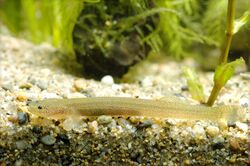Biology:Luciogobius
| Luciogobius | |
|---|---|

| |
| Luciogobius guttatus | |
| Scientific classification | |
| Domain: | Eukaryota |
| Kingdom: | Animalia |
| Phylum: | Chordata |
| Class: | Actinopterygii |
| Order: | Gobiiformes |
| Family: | Oxudercidae |
| Subfamily: | Gobionellinae |
| Genus: | Luciogobius T. N. Gill, 1859 |
| Type species | |
| Luciogobius guttatus T. N. Gill, 1859
| |
| Synonyms | |
| |
Luciogobius is a genus of goby in the subfamily of Gobionellinae, commonly called worm gobies. It is distributed along the coast of northeastern Asia, where species can be found in Korea, China , Taiwan, and Japan . Most species occur in Japan, and several are endemic.[1]
These gobies are unusual in appearance and habitat preference. They are small fish, about 2 to 7 cm (0.8–2.8 in) long, with very elongated bodies. The vertebral column is flexible and finely segmented, with many more vertebrae than most other fish in the family; they have up to 50 vertebrae, whereas most gobies have about 26. This extra-segmented spine helps Luciogobius species burrow in their common habitat, gravel beaches. Most vertebrates would have difficulty living in gravel that is constantly stirred by tidal action, but the flexibility of the bodies of Luciogobius is likely an adaptation to this environment. They also lack scales and the first dorsal fin.[2] Two species, L. albus and L. pallidus, are cave-adapted and live in anchialine waters.[3]
Other habitat types occupied by species in the genus include estuaries, freshwater streams, and in the case of L. adapel, the seafloor up to 50 m (160 ft).[4]
Most of the species studied spawn in the intertidal zone, but one species has been observed spawning in freshwater rivers. The eggs are generally attached to the undersides of rocks or are buried in the gravel or stone substrate.[4]
Species
There are currently 16 recognized species in this genus.[5] There are many more taxa known that are still undescribed, for a probable total of about 37 species.[1]
The described species are:[5]
- Luciogobius adapel Okiyama, 2001
- Luciogobius albus Regan, 1940
- Luciogobius ama (Snyder, 1909)
- Luciogobius brevipterus J. S. T. F. Chen, 1932
- Luciogobius dormitoris Shiogaki & Dotsu, 1976
- Luciogobius elongatus Regan, 1905
- Luciogobius fluvialis Kanagawa, Itai & Senou, 2011
- Luciogobius fonticola Kanagawa, Itai & Senou, 2011
- Luciogobius grandis R. Arai, 1970
- Luciogobius guttatus T. N. Gill, 1859 (flat-headed goby)
- Luciogobius koma (Snyder, 1909)
- Luciogobius pallidus Regan, 1940
- Luciogobius parvulus (Snyder, 1909)
- Luciogobius platycephalus Shiogaki & Dotsu, 1976
- Luciogobius ryukyuensis I. S. Chen, T. Suzuki & Senou, 2008[6]
- Luciogobius saikaiensis Dotsu, 1957
References
- ↑ 1.0 1.1 Kanagawa, N., et al. (2011). Two new species of freshwater gobies of the genus Luciogobius (Perciformes: Gobiidae) from Japan. Bull Kanagawa Prefect Mus (Nat Sci) 40, 67-74.
- ↑ Yamada, T., et al. (2009). Adaptive radiation of gobies in the interstitial habitats of gravel beaches accompanied by body elongation and excessive vertebral segmentation. BMC Evolutionary Biology 9 145.
- ↑ Romero, Aldemaro, editor (2001). The Biology of Hypogean Fishes. Developments in Environmental Biology of Fishes. ISBN:978-1402000768
- ↑ 4.0 4.1 Kondo, M., et al. (2012). Spawning habitat and early development of Luciogobius ryukyuensis (Gobiidae). Environmental Biology of Fishes 95(2), 291-300.
- ↑ 5.0 5.1 Froese, Rainer and Pauly, Daniel, eds. (2013). Species of Luciogobius in FishBase. June 2013 version.
- ↑ Chen, I. S., et al. (2008). A new species of gobiid fish, Luciogobius from Ryukyus, Japan (Teleostei: Gobiidae). Journal of Marine Science and Technology 16(4), 250-54.
Wikidata ☰ Q1062118 entry
 |

